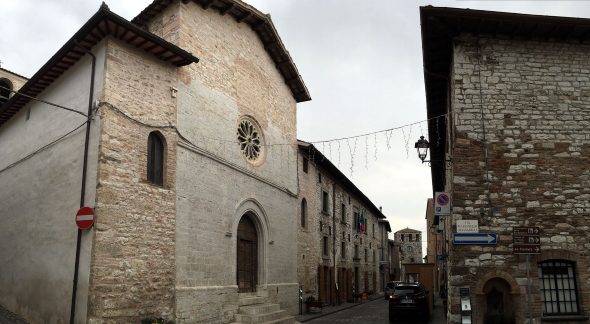La chiesa di San Francesco è un’opera dell’architetto Fra’Bevignate ed è situata nello stesso sito dove precedentemente si trovava la residenza degli Spadalonga, alcuni amici di Francesco, i quali gli offrirono una calda ospitalità quando lasciò la casa del padre per iniziare il cammino di predicazione e penitenza. Traccia dei muri della Casa degli Spadalonga è conservata e ben visibile nella sacrestia.
La chiesa, l’unica della città con una navata centrale e due navate laterali, fu costruita nella seconda metà del XIII secolo. I pilastri ottagonali sostengono la volta situata alla stessa altezza nelle tre navate. Le volte e i capitelli sono il risultato del restauro del XVIII secolo.
>>Vuoi vedere Gubbio? Consulta ora le offerte dei migliori hotel nelle vicinanze.
![]()
>> Ci sono offerte in scadenza per agriturismi nella zona di Gubbio! Clicca e consultale subito.
Nel Convento è notevole, per il suo valore storico-artistico, il “Chiostro della pace”, sul quale si affaccia la “Sala del Capitolo” dove, un tempo, i frati si riunivano per decidere sulle norme della loro vita conventuale (quando non fu più utilizzata per tali scopi, per molti anni e fino pochi decenni fa ha rappresentato il magazzino di deposito del sale dei Monopoli di Stato, la cosiddetta: “salara”). Dallo stesso “chiostro della pace” si accede al “Refettorio”, ora trasformato in sala congressi, e al “chiostro maggiore”, il vero e proprio chiostro del convento, non aperto al pubblico, se non in occasioni eccezionali come rassegne d’arte e spettacoli classici.
Nello spazio tra la chiesa e l’ospedale, al confine dell’orto dei frati, è stato posto nel 1997 un monumento che raffigura S. Francesco e il lupo. L’opera, dell’artista Roberto Bellucci, è stata realizzata da un comitato cittadino insieme al contributo del Comune e delle antiche corporazioni medioevali come l’Università dei Muratori, dei Fabbri, dei Falegnami, dei Calzolari, dei Sarti e della Società Operaia di Mutuo Soccorso.
All’interno della chiesa gli affreschi della capella sul lato sinistro sono particolarmente interessanti: le “Storie della Vergine” di Ottaviano Nelli (intorno al 1400), Madonna con Bambino, S. Cristoforo, S.Antonio Abbate ed altri dipinti del XV secolo nella cappella di destra.
Il luogo è attualmente la sede della Pinacoteca Comunale.
>>Se hai deciso di visitare Gubbio ti consigliamo di contattare ora gli hotel nelle sue vicinanze >> clicca questo link.
The St. Francis church is a work of architect Fra’Bevignate and is situated on the same site where, previously, the residence of the Spadalongas was.
The latter were some friends of Francesco, who offered him hospitality when he left his father’s house. The church, the only one of the city with one central nave and two lateral ones, was constructed in the second half of XIII century. The octagonal pillars support the vault, situated at the same height of the three naves. The vaults andcapitals result from a restoration in the XVIII century. At the inside of the church, in the left chapel, threre are frescoes of particular interest: the “History of the Virgin” By Ottaviano Nelli (around to the 1400); Madonna with Child, S. Cristoforo, S. Antonio Abbate and other paintings of XV the century in the right nail head.
Currently the curch hosts the Communal Pinacotheca.
The St. Francis church is a work of architect Fra’Bevignate and is situated on the same site where, previously, the residence of the Spadalongas was.
The latter were some friends of Francesco, who offered him hospitality when he left his father’s house. The church, the only one of the city with one central nave and two lateral ones, was constructed in the second half of XIII century. The octagonal pillars support the vault, situated at the same height of the three naves. The vaults andcapitals result from a restoration in the XVIII century. At the inside of the church, in the left chapel, threre are frescoes of particular interest: the “History of the Virgin” By Ottaviano Nelli (around to the 1400); Madonna with Child, S. Cristoforo, S. Antonio Abbate and other paintings of XV the century in the right nail head.
Currently the curch hosts the Communal Pinacotheca.
The St. Francis church is a work of architect Fra’Bevignate and is situated on the same site where, previously, the residence of the Spadalongas was.
The latter were some friends of Francesco, who offered him hospitality when he left his father’s house. The church, the only one of the city with one central nave and two lateral ones, was constructed in the second half of XIII century. The octagonal pillars support the vault, situated at the same height of the three naves. The vaults andcapitals result from a restoration in the XVIII century. At the inside of the church, in the left chapel, threre are frescoes of particular interest: the “History of the Virgin” By Ottaviano Nelli (around to the 1400); Madonna with Child, S. Cristoforo, S. Antonio Abbate and other paintings of XV the century in the right nail head.
Currently the curch hosts the Communal Pinacotheca.
The St. Francis church is a work of architect Fra’Bevignate and is situated on the same site where, previously, the residence of the Spadalongas was.
The latter were some friends of Francesco, who offered him hospitality when he left his father’s house. The church, the only one of the city with one central nave and two lateral ones, was constructed in the second half of XIII century. The octagonal pillars support the vault, situated at the same height of the three naves. The vaults andcapitals result from a restoration in the XVIII century. At the inside of the church, in the left chapel, threre are frescoes of particular interest: the “History of the Virgin” By Ottaviano Nelli (around to the 1400); Madonna with Child, S. Cristoforo, S. Antonio Abbate and other paintings of XV the century in the right nail head.
Currently the curch hosts the Communal Pinacotheca.



Comment (0)